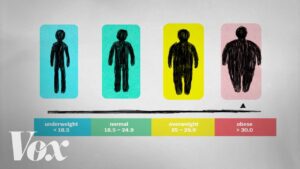Body Mass Index (BMI) Explained is a way to compare your height and weight and create an objective way to compare the body habitus of different individuals. MORE HEALTH EDUCATION: https://www.youtube.com/playlist?list=PLt6puIp2CPGX8ilSikABEAc0wiS-slL-h READ MORE https://www.healthydocs.net/home/2017/body-mass-index-explained Click link above for BMI calculator Please like, subscribe, comment and share! Follow me: SUBSCRIBE: https://www.youtube.com/user/DrJohnKiel FACEBOOK: https://www.facebook.com/medicinelifestyle TWITTER: https://twitter.com/LifestyleMedYou INSTAGRAM: https://www.instagram.com/drjohnkiel/ PINTEREST: https://www.pinterest.com/jkielmph/ Check out my website: http://healthydocs.net/ In this video I briefly describe what body mass index is, the health risks associated with it and it’s limitations. BMI is regularly used to measure whether an individual is underweight, normal weight, overweight or obese. A high BMI ( greater than 25 overweight, greater than 30 obese) is associated with a myriad of health risks BMI has two major limitations. It’s accuracy varies by race and is limited in individuals with lean muscle mass. Body mass index, also known as BMI, is an objective way to describe someone’s height and weight. Overweight and obese BMI are associated with a ton of diseases such as diabetes, heart disease and strokes. Research has shown that in individuals with a BMI over 25 (classified as overweight) and a BMI over 30 (classified as obese) the risks for the following conditions also increases: Death from any cause (all cause mortality) Coronary heart disease (heart attack) Type 2 diabetes Cancers (endometrial, breast, and colon) Hypertension (high blood pressure) Dyslipidemia (high cholesterol, triglycerides) Stroke (cerebrovascular accident) Liver and Gallbladder disease Sleep apnea and respiratory problems Osteoarthritis (a degeneration of cartilage and its underlying bone within a joint) Gynecological problems (abnormal menses, infertility) Metabolic syndrome

Body Mass Index (BMI) Explained (Made Simple To Understand) – Updated
- Post author:
- Post published:May 17, 2021
- Post category:Uncategorized
- Post comments:0 Comments
You Might Also Like

Branches of Physiotherapy Video – 16

How to Deal With Morning Sickness During Pregnancy? | Dr. Jyoti Kala

Spa Products Video – 4

Muscle Building Workout & Squats Video – 36

How do you check your kidney function ?

2 NO CHEAT Side Lateral Raise Variations You Should Use On Shoulder Day
![Read more about the article Top 5 Vitamins to Build Muscle & Gain Weight [HD]](https://videos.drmaheshkumar.com/wp-content/uploads/2021/05/Top-5-Vitamins-to-Build-Muscle-Gain-Weight-HD-300x225.jpg)
Top 5 Vitamins to Build Muscle & Gain Weight [HD]

How to Warm Up before Sprinting | Sprinting

What is Acne and How Do I Get Rid of it Forever? | Allure

Cure Cirrhosis With This Recipe – Homeveda Shorts

BCAAs Explained in 60 seconds – Should You Supplement With BCAAs?

Here is Why Walking is Better Than Running

Stability Ball: Back Extension
Latissimus Dorsi Bent Over Row-11

Standing Calf Raise-3

History Of Medicine Video – 1

Lying Triceps Extension-5

Breads For Your Weight Loss Diets

What are the normal levels of T3, T4,TSH & causes for Thyroid Disorders? – Dr. Sanjay Panicker

4 Best Glucometers in India with Price

How to Produce More Milk – breastfeeding tips

Sex Hormones and Drugs

Metabolism, Anabolism, Catabolism – SCIENTIFIC VIEW | by Abhinav Tonk

How To: Dumbbell Tricep Press

Health And Fitness Video – 7

Easy Warm Up Cardio Workout – Fitness Blender Warm Up Workout

Pre diabetes Symptoms Explained By Dr.Berg

Echo made easy

Seated Dumbbell Bicep Curls

HYPOTENSION APPARATUS

What BMI doesn’t tell you about your health

Insulin Applications in Bodybuilding with Colette Nelson

Torso muscles origin/insertion

Lifestage Nutrition Video – 2

Physiotherapy in Rehabilitation Video – 1

Why You Need Vitamin B Complex

Routes of drug entry | Processing the Environment | MCAT | Khan Academy

Forearm Training Tips

ON Glutamine Powder Review | Body Spartan Recommendations

Side Effects of Omega 3 Supplements | BestFishOill.com

Physiotherapy in Obstetrics Video – 2

